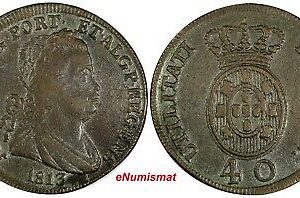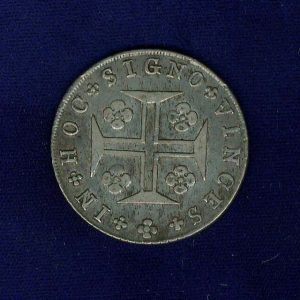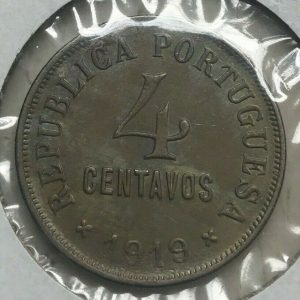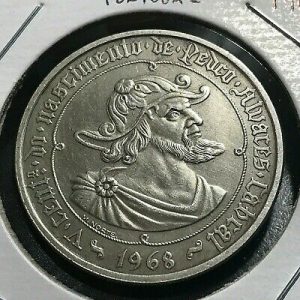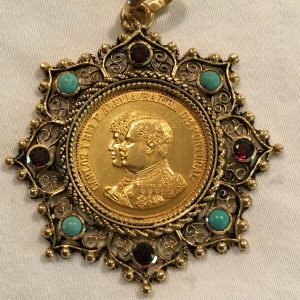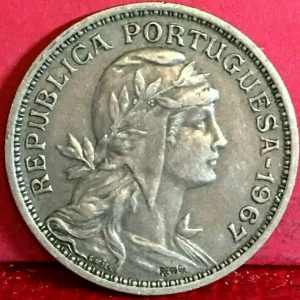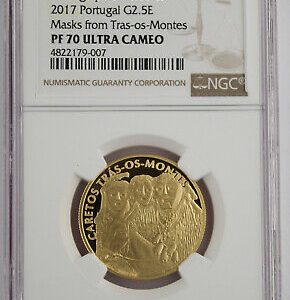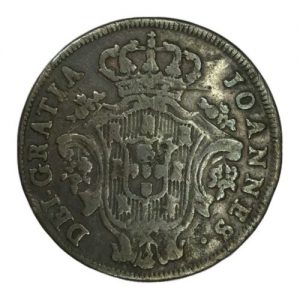|
Portugal – Golden Age of Portuguese Discoveries – Bartolomeu Dias
1988 Proof Silver 100 Escudos 33mm (16.57 grams) 0.925 Silver (0.4907 oz. ASW)
Reference: KM# 642a
REPUBLICA·PORTUGUESA 100$00, Shield within circle.
BARTOLOMEU DIAS CABO DA BOA ESPERANCA JORGE VIERIA incm 1488 1988, 500 year anniversary of the rounding of the Cape of Good Hope by Bartolomeu Dias. Map of Africa leaning south to the left and two inverted boats, caravels with lateen sails, surrounded by the names of the explorer and the Cape.
You are bidding on the exact item pictured, provided with a Certificate of Authenticity and Lifetime Guarantee of Authenticity.
.JPG/220px-Bartolomeu_Dias,_South_Africa_House_(cut).JPG) Bartolomeu Dias (Anglicized: Bartholomew Diaz; c. 1450 – 29 May 1500), a nobleman of the Portuguese royal household, was a Portuguese explorer. He sailed around the southernmost tip of Africa in 1488, the first European to do so, setting up the route from Europe to Asia later on. Dias is the first European during the Age of Discovery to anchor at what is present-day South Africa. Bartolomeu Dias (Anglicized: Bartholomew Diaz; c. 1450 – 29 May 1500), a nobleman of the Portuguese royal household, was a Portuguese explorer. He sailed around the southernmost tip of Africa in 1488, the first European to do so, setting up the route from Europe to Asia later on. Dias is the first European during the Age of Discovery to anchor at what is present-day South Africa.
Historical setting and purposes of the Dias expedition
Bartolomeu Dias was a squire of the royal court, superintendent of the royal warehouses, and sailing-master of the man-of-war São Cristóvão (Saint Christopher). Very little is known of his early life. King John II of Portugal appointed him, on 10 October 1486, to head an expedition to sail around the southern tip of Africa in the hope of finding a trade route to India. Dias was also charged with searching for the lands ruled by Prester John, a fabled Christian priest and ruler of territory somewhere beyond Europe. He left 10 months later in August 1487. In the previous decades Portuguese mariners, most famously Prince Henry the Navigator (whose contribution was more as a patron and sponsor of voyages of discovery than as a sailor), had explored the areas of the Atlantic Ocean off Southern Europe and Western Africa as far as the Cape Verde Islands and modern-day Sierra Leone, and had gained sufficient knowledge of oceanic shipping and wind patterns to enable subsequent voyages of greater distance. In the early 1480s Diogo Cão in two voyages (he died towards the end of the second) had explored the mouth of the Congo River and sailed south of the Equator to present-day Angola and Namibia.
The Journey
 São Cristóvão was piloted by Pêro de Alenquer. A second caravel, the São Pantaleão, was commanded by João Infante and piloted by Álvaro Martins. Dias’s brother Pêro Dias was the captain of the square-rigged support ship with João de Santiago as pilot. São Cristóvão was piloted by Pêro de Alenquer. A second caravel, the São Pantaleão, was commanded by João Infante and piloted by Álvaro Martins. Dias’s brother Pêro Dias was the captain of the square-rigged support ship with João de Santiago as pilot.
The expedition sailed down the west coast of Africa; provisions were picked up on the way at the Portuguese fortress of São Jorge de Mina on the Gold Coast. After sailing south of modern-day Angola, Dias reached the Golfo da Conceicão (Walvis Bay, in modern Namibia) by December. Continuing south, he discovered Angra dos Ilheus, then was hit by a violent storm. Thirteen days later, from the open ocean, he searched the coast again to the east, discovering and using the westerlies winds-the ocean gyre, but finding just ocean. Having rounded the Cape of Good Hope at a considerable distance to the west and southwest, he turned east, and taking advantage of the winds of Antarctica that blow strongly in the South Atlantic, sailed northeast. After 30 days without seeing land, he entered what he named Aguada de São Brás (Bay of Saint Blaise)-later renamed Mossel Bay-on 4 February 1488. Dias’s expedition reached its furthest point on 12 March 1488 when it anchored at Kwaaihoek, near the mouth of the Boesmans River, where a padrão-the Padrão de São Gregório-was erected before turning back. Dias wanted to continue to India, but he was forced to turn back when his crew refused to go further and the rest of the officers unanimously favoured returning to Portugal. It was only on the return voyage that he actually discovered the Cape of Good Hope, in May 1488. Dias returned to Lisbon in December of that year, after an absence of 16 months and 17 days.
The discovery of the passage around southern Africa was significant because, for the first time, Europeans could trade directly with India and the Far East, bypassing the overland Euro-Asian route with its expensive European, Middle Eastern and Central Asian middlemen. The official report of the expedition has been lost.
Dias originally named the Cape of Good Hope the Cape of Storms (Cabo das Tormentas). It was later renamed (by King John II of Portugal) the Cape of Good Hope (Cabo da Boa Esperança) because it represented the opening of a route to the east.
Follow-up voyages
After these early attempts, the Portuguese took a decade-long break from Indian Ocean exploration. During that hiatus, it is likely that they received valuable information from a secret agent, Pêro da Covilhã, who had been sent overland to India and returned with reports useful to their navigators.
Using his experience with explorative travel, Dias helped in the construction of the São Gabriel and its sister ship the São Rafael that were used in 1498 by Vasco da Gama to sail past the Cape of Good Hope and continue to India. Dias only participated in the first leg of Da Gama’s voyage, until the Cape Verde Islands. Two years later he was one of the captains of the second Indian expedition, headed by Pedro Álvares Cabral. This flotilla first reached the coast of Brazil, landing there in 1500, and then continued east to India. Dias perished near the Cape of Good Hope that he presciently had named Cape of Storms. Four ships, including Dias’s, encountered a huge storm off the cape and were lost on 29 May 1500. A shipwreck found in 2008 by the Namdeb Diamond Corporation off Namibia was at first thought to be Dias’s ship, but recovered coins come from a later time.
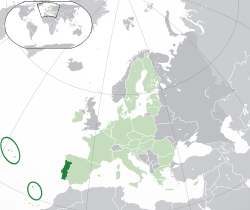  Portugal, officially the Portuguese Republic (Portuguese: República Portuguesa), is a country on the Iberian Peninsula, in Southwestern Europe. It is the westernmost country of mainland Europe, being bordered by the Atlantic Ocean to the west and south and by Spain to the north and east. The Portugal-Spain border is 1,214 km (754 mi) long and considered the longest uninterrupted border within the European Union. The republic also includes the Atlantic archipelagos of the Azores and Madeira, both autonomous regions with their own regional governments. Portugal, officially the Portuguese Republic (Portuguese: República Portuguesa), is a country on the Iberian Peninsula, in Southwestern Europe. It is the westernmost country of mainland Europe, being bordered by the Atlantic Ocean to the west and south and by Spain to the north and east. The Portugal-Spain border is 1,214 km (754 mi) long and considered the longest uninterrupted border within the European Union. The republic also includes the Atlantic archipelagos of the Azores and Madeira, both autonomous regions with their own regional governments.
 The territory of modern Portugal has been continuously settled, invaded and fought over since prehistoric times. The Pre-Celts, Celts, Phoenicians, Carthaginians and the Romans were followed by the invasions of the Visigothic and the Suebi Germanic peoples, who were themselves later invaded by the Moors. These Muslim peoples were eventually expelled during the Christian Reconquista. Portuguese nationality can be traced back to the creation of the First County of Portugal, in 868. In 1139, Afonso Henriques was proclaimed King of Portugal, thus firmly establishing Portuguese independence, under the Portuguese House of Burgundy. The territory of modern Portugal has been continuously settled, invaded and fought over since prehistoric times. The Pre-Celts, Celts, Phoenicians, Carthaginians and the Romans were followed by the invasions of the Visigothic and the Suebi Germanic peoples, who were themselves later invaded by the Moors. These Muslim peoples were eventually expelled during the Christian Reconquista. Portuguese nationality can be traced back to the creation of the First County of Portugal, in 868. In 1139, Afonso Henriques was proclaimed King of Portugal, thus firmly establishing Portuguese independence, under the Portuguese House of Burgundy.
In the 15th and 16th centuries, under the House of Aviz, which took power following the 1383-85 Crisis, Portugal expanded Western influence and established the first global empire, becoming one of the world’s major economic, political and military powers. During this time, Portuguese explorers pioneered maritime exploration in the Age of Discovery, notably under royal patronage of Prince Henry the Navigator and King João II, with such notable discoveries as Vasco da Gama’s sea route to India (1497-98), Pedro Álvares Cabral’s discovery of Brazil (1500), and Bartolomeu Dias’s reaching of the Cape of Good Hope. Portugal monopolized the spice trade during this time, under royal command of the Casa da Índia, and the Portuguese Empire expanded with military campaigns led in Asia, notably under Afonso de Albuquerque, who was known as the ‘Caesar of the East’.
The destruction of Lisbon in a 1755 earthquake, the country’s occupation during the Napoleonic Wars, the independence of Brazil (1822), and the Liberal Wars (1828-1834), all left Portugal crippled from war and diminished in its world power. After the 1910 revolution deposed the monarchy, the democratic but unstable Portuguese First Republic was established, later being superseded by the ‘Estado Novo’ right-wing authoritarian regime. Democracy was restored after the Portuguese Colonial War and the Carnation Revolution in 1974. Shortly after, independence was granted to all its colonies and East Timor, with the exception of Macau, which was handed over to China in 1999. This marked the end of the longest-lived European colonial empire, leaving a profound cultural and architectural influence across the globe and a legacy of over 250 million Portuguese speakers today.
Portugal is a developed country with a high-income advanced economy and high living standards. It is the 5th most peaceful country in the world, maintaining a unitary semi-presidential republican form of government. It has the 18th highest Social Progress in the world, putting it ahead of other Western European countries like France, Spain and Italy. It is a member of numerous international organizations, including the United Nations, the European Union, the eurozone, OECD, NATO and the Community of Portuguese Language Countries. Portugal is also known for having decriminalized the usage of all common drugs in 2001, the first country in the world to do so. However, the sale and distribution of these drugs is still illegal in Portugal.
|

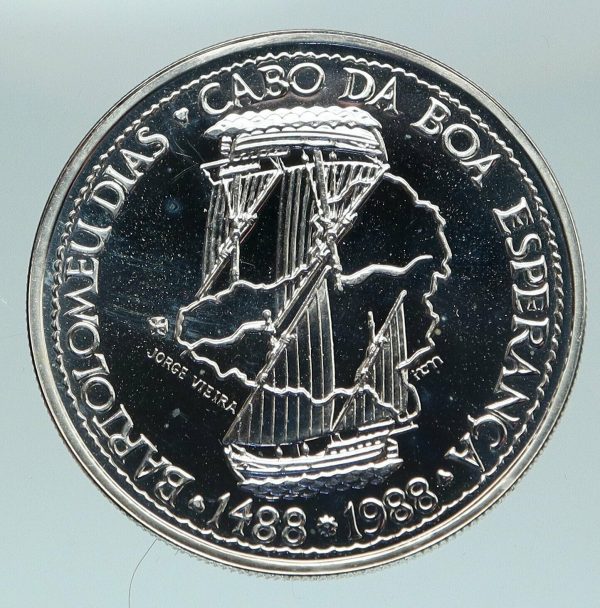
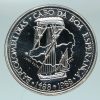
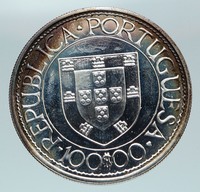
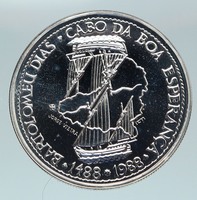
.JPG/220px-Bartolomeu_Dias,_South_Africa_House_(cut).JPG) Bartolomeu Dias (Anglicized: Bartholomew Diaz; c. 1450 – 29 May 1500), a nobleman of the Portuguese royal household, was a Portuguese explorer. He sailed around the southernmost tip of Africa in 1488, the first European to do so, setting up the route from Europe to Asia later on. Dias is the first European during the Age of Discovery to anchor at what is present-day South Africa.
Bartolomeu Dias (Anglicized: Bartholomew Diaz; c. 1450 – 29 May 1500), a nobleman of the Portuguese royal household, was a Portuguese explorer. He sailed around the southernmost tip of Africa in 1488, the first European to do so, setting up the route from Europe to Asia later on. Dias is the first European during the Age of Discovery to anchor at what is present-day South Africa. São Cristóvão was piloted by Pêro de Alenquer. A second caravel, the São Pantaleão, was commanded by João Infante and piloted by Álvaro Martins. Dias’s brother Pêro Dias was the captain of the square-rigged support ship with João de Santiago as pilot.
São Cristóvão was piloted by Pêro de Alenquer. A second caravel, the São Pantaleão, was commanded by João Infante and piloted by Álvaro Martins. Dias’s brother Pêro Dias was the captain of the square-rigged support ship with João de Santiago as pilot.
 Portugal, officially the Portuguese Republic (Portuguese: República Portuguesa), is a country on the Iberian Peninsula, in Southwestern Europe. It is the westernmost country of mainland Europe, being bordered by the Atlantic Ocean to the west and south and by Spain to the north and east. The Portugal-Spain border is 1,214 km (754 mi) long and considered the longest uninterrupted border within the European Union. The republic also includes the Atlantic archipelagos of the Azores and Madeira, both autonomous regions with their own regional governments.
Portugal, officially the Portuguese Republic (Portuguese: República Portuguesa), is a country on the Iberian Peninsula, in Southwestern Europe. It is the westernmost country of mainland Europe, being bordered by the Atlantic Ocean to the west and south and by Spain to the north and east. The Portugal-Spain border is 1,214 km (754 mi) long and considered the longest uninterrupted border within the European Union. The republic also includes the Atlantic archipelagos of the Azores and Madeira, both autonomous regions with their own regional governments. The territory of modern Portugal has been continuously settled, invaded and fought over since prehistoric times. The Pre-Celts, Celts, Phoenicians, Carthaginians and the Romans were followed by the invasions of the Visigothic and the Suebi Germanic peoples, who were themselves later invaded by the Moors. These Muslim peoples were eventually expelled during the Christian Reconquista. Portuguese nationality can be traced back to the creation of the First County of Portugal, in 868. In 1139, Afonso Henriques was proclaimed King of Portugal, thus firmly establishing Portuguese independence, under the Portuguese House of Burgundy.
The territory of modern Portugal has been continuously settled, invaded and fought over since prehistoric times. The Pre-Celts, Celts, Phoenicians, Carthaginians and the Romans were followed by the invasions of the Visigothic and the Suebi Germanic peoples, who were themselves later invaded by the Moors. These Muslim peoples were eventually expelled during the Christian Reconquista. Portuguese nationality can be traced back to the creation of the First County of Portugal, in 868. In 1139, Afonso Henriques was proclaimed King of Portugal, thus firmly establishing Portuguese independence, under the Portuguese House of Burgundy.

